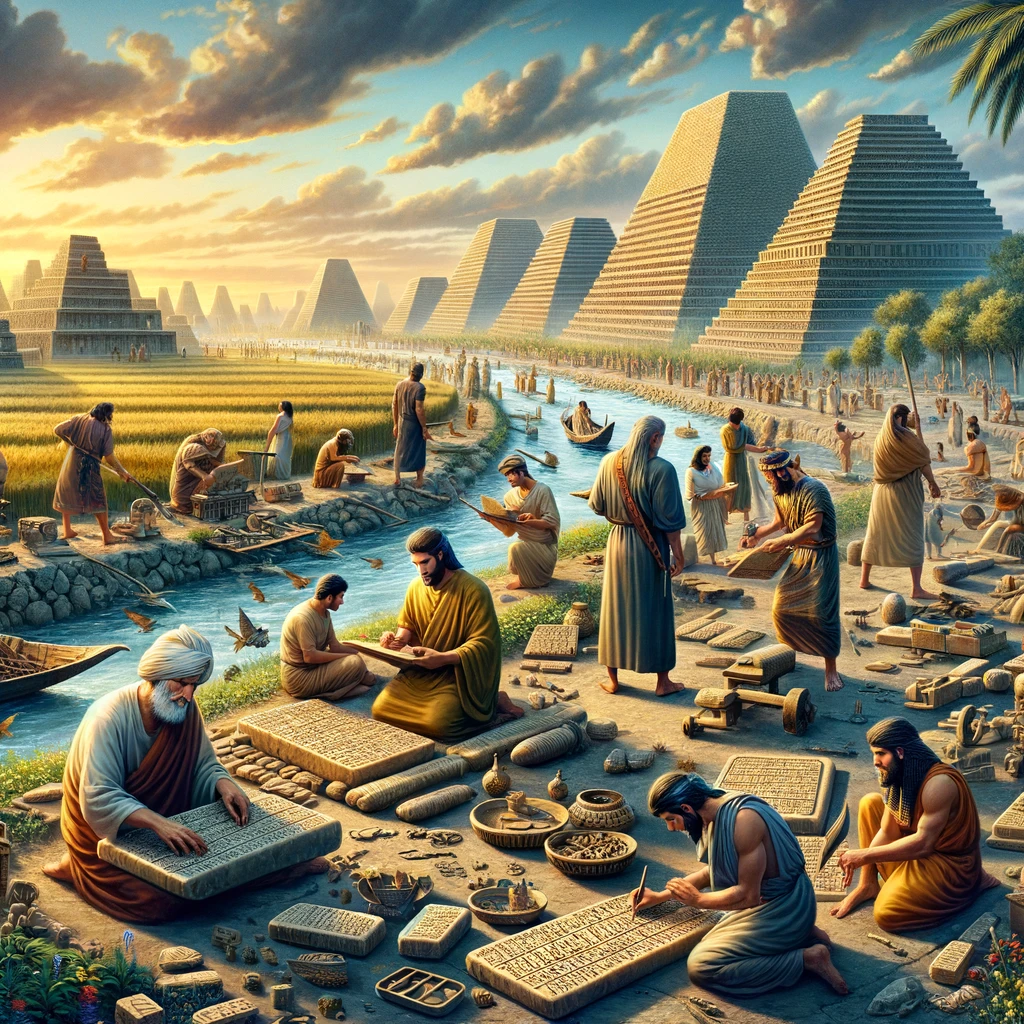Welcome to our journey into the fascinating world of the Sumerians, who were the pioneers of Mesopotamia. In this article, we will delve into their rich civilization and explore the significant contributions they made to Mesopotamian history. The Sumerians were not only innovators but also laid the foundation for future societies with their remarkable achievements in various fields.
Key Takeaways:
- The Sumerians played a crucial role in shaping Mesopotamian history.
- Their advancements in art and architecture set the stage for monumental structures.
- The Sumerians developed the earliest known writing system, known as cuneiform.
- Ancient Sumer had a hierarchical social structure consisting of three distinct classes.
- The legacy of the Sumerians continues to influence modern civilizations.
Sumerian Achievements: Innovation in Art and Architecture
The Ancient Sumerians were pioneers in monumental architecture and made remarkable advancements in art and architecture. Their contributions to a Mesopotamian culture shaped the artistic landscape of the region.
One notable example of their architectural prowess is the temple at Abū Shahrayn. This impressive structure showcases the early architectural design and engineering skills of the Sumerians. It served as a place of worship and a symbol of the city-state’s power and wealth.
The Sumerians also excelled in sculpture, using imported stone to create masterpieces that exhibited a unique geometric simplification and occasional naturalistic features. These sculptures laid the foundation for future artistic expressions and greatly influenced the art of subsequent civilizations.
As we explore the Sumerian innovations in art and architecture, we gain a deeper understanding of their cultural achievements and the lasting impact they had on the development of ancient Mesopotamian civilization.
| Key Sumerian Art and Architecture Innovations | Impact on Mesopotamian Culture |
|---|---|
| Monumental architecture | Symbol of power and wealth |
| Unique sculptural style | Influence on future artistic expressions |
The Birth of Writing: Sumerian Contributions
The Sumerians are credited with developing the earliest known writing system, making significant contributions to the world of written communication. They paved the way for future civilizations by creating a sophisticated system that evolved from pictographs to cuneiform.
Initially, the Sumerians used pictographs, which were simple drawings representing objects or ideas. These pictographs gradually evolved into a more complex script called cuneiform. The Sumerians utilized wedge-shaped marks on clay tablets to form their written language, allowing for a more efficient and versatile means of communication.
Cuneiform became the dominant writing system in ancient Mesopotamia, and the Sumerians’ innovation had a lasting impact on subsequent civilizations. It was adopted and further developed by cultures such as the Akkadians, Assyrians, and Babylonians, who recognized its practicality and adaptability.
By employing this sophisticated writing system, the Sumerians not only preserved their history and literature but also facilitated trade, governance, and cultural exchange. Cuneiform tablets have provided invaluable insights into various aspects of Sumerian society, including religion, law, and economic practices.
The achievements of the Sumerians in developing the earliest writing system demonstrate their remarkable intellectual prowess and foresight. Their pioneering efforts laid the foundation for the evolution of writing systems across the globe, enabling the recorded history of humanity to begin.
Social Structure in Ancient Sumer
Ancient Sumerian society, one of the earliest civilizations known to humanity, was characterized by a well-defined hierarchical structure that played a crucial role in its social, economic, and political organization. This structure was divided into three distinct social classes, each with its own set of roles, responsibilities, and ways of life, reflecting the complexity and sophistication of Sumerian civilization.
The Upper Class
At the pinnacle of Sumerian society was the upper class, comprised of priests, landowners, high-ranking officials, and royalty. This echelon was distinguished by its immense privilege and power, with its members wielding significant influence over both the religious and administrative spheres of Sumerian life. Priests, for instance, were not only spiritual leaders but also played key roles in governing the city-states, often acting as intermediaries between the gods and the people. Landowners and officials controlled vast swathes of agriculture, which was the backbone of the Sumerian economy, thereby ensuring their wealth and status within society.
Members of the upper class enjoyed opulent lifestyles, living in expansive and elaborately decorated houses that stood in stark contrast to the simpler abodes of the lower classes. They had access to a variety of luxuries, including fine clothing made from imported materials, exotic foods, and sophisticated items of personal adornment. Their social functions often included elaborate ceremonies and feasts, which underscored their status at the top of the social hierarchy.
The Common Class
Below the upper class was the common class, which formed the backbone of Sumerian society. This class was primarily made up of merchants, craftsmen, farmers, and artisans – the people who drove the city-state’s economy through their various trades and skills. Merchants engaged in trade with distant lands, bringing in goods that were not locally available. Craftsmen and artisans produced a wide range of goods, from everyday household items to more luxurious goods for the upper class. Farmers, on the other hand, were responsible for cultivating the land and producing the food that sustained the population.
The common class lived in conditions that were modest yet significantly more comfortable than those of the lower class. Their houses, while not as grand as those of the upper class, were functional and provided a decent standard of living. They also had access to public amenities and were able to participate in the religious and cultural life of the city-state, which was central to Sumerian society.
The Bottom Class
At the base of the social pyramid were the slaves, who occupied the lowest tier of Sumerian society. Slavery in ancient Sumer was a widespread institution, with slaves being considered the property of their masters. They had no personal rights or freedoms and could be bought, sold, or traded at their owner’s discretion. Slaves were employed in a variety of roles, from domestic servants to laborers in the fields and temples. They were integral to the functioning of the upper and common classes, performing tasks that were essential yet deemed undesirable by the free population.
The living conditions of slaves were markedly inferior to those of the other classes. They lived in cramped and rudimentary quarters, often within the households of their owners or in communal barracks. Their diet and personal belongings were basic, reflecting their status at the very bottom of the social ladder.
“The social structure of ancient Sumer reflects the unequal distribution of power and resources, with the upper class benefiting from their privileged positions while the bottom class endured hardships as slaves.”
Despite the social divisions, there were opportunities for individuals to move up in society. Successful merchants, for example, could accumulate wealth and elevate their social standing. However, social mobility was limited, and the hierarchical structure remained a dominant feature of Sumerian society.
Conclusion
In conclusion, the Sumerians were pioneers in Mesopotamian history, leaving an indelible mark through their remarkable achievements. Their innovations in art and architecture served as a foundation for future civilizations, showcasing their advanced artistic skills and architectural designs. From monumental structures like the temple at Abū Shahrayn to intricately carved sculptures, the Sumerians demonstrated their mastery of creative expression.
One of the most significant contributions of the Sumerians was the development of the earliest known writing system. Their evolution from pictographs to cuneiform paved the way for written communication and became the basis for subsequent writing systems in the region. The Sumerians’ dedication to preserving their history and knowledge through writing was crucial in the advancement of future civilizations.
Religion played a central role in Sumerian society, evolving alongside urbanization. The Sumerians believed in a pantheon of gods and goddesses, attributing natural phenomena, farming, and other aspects of daily life to their actions. Temples served as religious and administrative centers, serving as a testament to the spiritual devotion and organizational skills of the Sumerian people.
By studying the achievements of the Sumerians, we gain valuable insights into the foundations of human civilization. Their cultural, technological, and social advancements laid the groundwork for the development of complex societies and shaped the course of history. The legacy of the Sumerians continues to influence modern society, making their contributions to Mesopotamian history invaluable.
FAQ
Who were the Sumerians?
The Sumerians were the pioneers of Mesopotamia, known for their significant contributions to ancient civilizations and Mesopotamian history.
What were the achievements of the Sumerians in art and architecture?
The Sumerians were pioneers in monumental architecture, with temples like the one at Abū Shahrayn showcasing early architectural design. Their sculptures, often made from stone imported from distant sources, displayed geometric simplification and occasional naturalistic aspirations.
What is the writing system developed by the Sumerians?
The Sumerians developed the earliest known writing system, evolving from pictographs to cuneiform. Initially logographic, it later incorporated photographic elements. This script was adopted by the Akkadians and further developed by the Assyrians and Babylonians.
How was social structure organized in ancient Sumer?
In ancient Sumer, society was structured into three classes – the upper class (priests, landowners, officials), the common class (merchants, craftsmen, farmers), and the bottom class (slaves). Each class had distinct roles and living conditions within the city-state.
What was the religious belief system of the Sumerians?
Sumerian religion was polytheistic, with deities representing cosmic and terrestrial forces. Initially involving gods like An, Enlil, Ninhursag, and Enki, their religion evolved as society urbanized. Deities lost their natural associations and became patrons of cities.
Where can I find more information about the Sumerians?
For more information about the Sumerians and their achievements, you can refer to reputable historical sources and scholarly studies. Here are some recommended citations:
- Crawford, H. (2004). Sumer and the Sumerians: The history, culture, and legacy of the ancient Mesopotamian empire. Routledge.
- Kramer, S. N. (1963). The Sumerians: Their history, culture, and character. University of Chicago Press.
- Leick, G. (2002). Mesopotamia: The invention of the city. Penguin Books.

